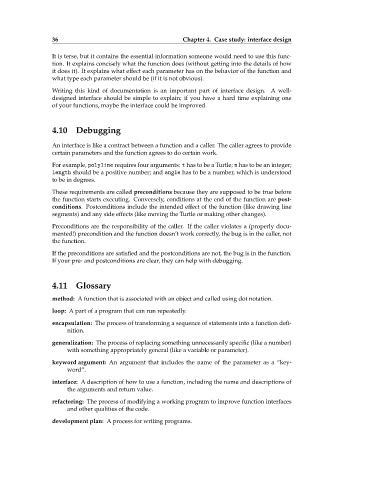Page 58 - thinkpython
P. 58
36 Chapter 4. Case study: interface design
It is terse, but it contains the essential information someone would need to use this func-
tion. It explains concisely what the function does (without getting into the details of how
it does it). It explains what effect each parameter has on the behavior of the function and
what type each parameter should be (if it is not obvious).
Writing this kind of documentation is an important part of interface design. A well-
designed interface should be simple to explain; if you have a hard time explaining one
of your functions, maybe the interface could be improved.
4.10 Debugging
An interface is like a contract between a function and a caller. The caller agrees to provide
certain parameters and the function agrees to do certain work.
For example, polyline requires four arguments: t has to be a Turtle; n has to be an integer;
length should be a positive number; and angle has to be a number, which is understood
to be in degrees.
These requirements are called preconditions because they are supposed to be true before
the function starts executing. Conversely, conditions at the end of the function are post-
conditions. Postconditions include the intended effect of the function (like drawing line
segments) and any side effects (like moving the Turtle or making other changes).
Preconditions are the responsibility of the caller. If the caller violates a (properly docu-
mented!) precondition and the function doesn’t work correctly, the bug is in the caller, not
the function.
If the preconditions are satisfied and the postconditions are not, the bug is in the function.
If your pre- and postconditions are clear, they can help with debugging.
4.11 Glossary
method: A function that is associated with an object and called using dot notation.
loop: A part of a program that can run repeatedly.
encapsulation: The process of transforming a sequence of statements into a function defi-
nition.
generalization: The process of replacing something unnecessarily specific (like a number)
with something appropriately general (like a variable or parameter).
keyword argument: An argument that includes the name of the parameter as a “key-
word”.
interface: A description of how to use a function, including the name and descriptions of
the arguments and return value.
refactoring: The process of modifying a working program to improve function interfaces
and other qualities of the code.
development plan: A process for writing programs.

